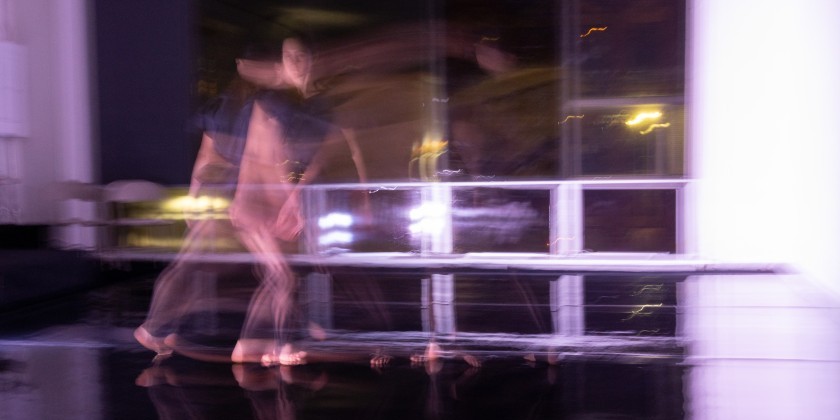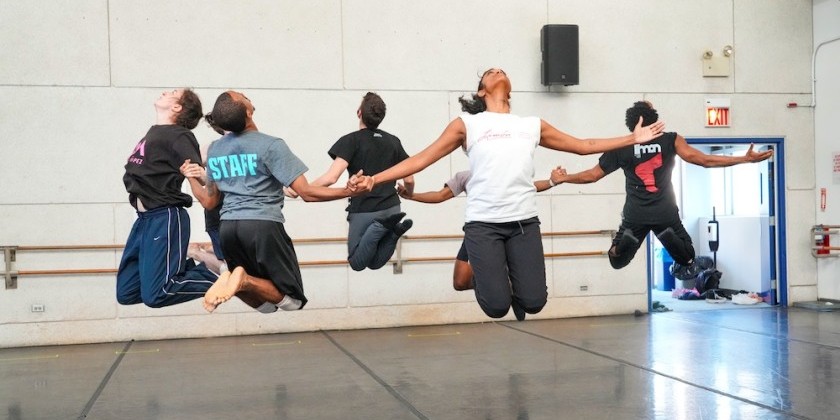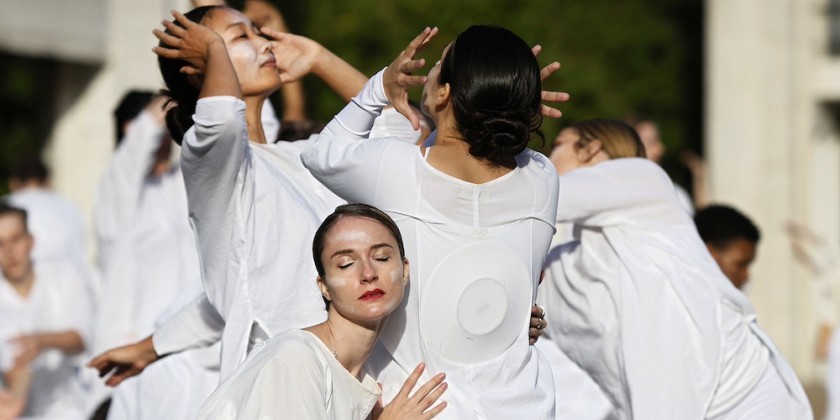A Day in the Life of New York Theatre Ballet as they work with British Choreographer Richard Alston

British Choreographer, Richard Alston,Creates "A Rugged Flourish" (World Premiere) on the dancers of The New York Theatre Ballet.
A Day in the Life of The New York Theatre Ballet: Celebrated British choreographer, Richard Alston, creates A Rugged Flourish for the companies last Signature Series performance of the 2011 Season.
Photos ©Julia Cervantes, 2011
Story ©Christine Jowers, 2011
How can the hard tips of pointe shoes illustrate a soft pliability? How can a performer move their arm to emphasize the lightness in a fairly jagged, earthbound sounding piece of music? What is the secret to a big kick not striking out like a chorus girl's discharged limb, but flowing elegantly to its highpoint?
As far as the kick (battement) is concerned, Alston coaches the dancers to think of their torsos and arms as more important then the leg.
"The battement just doesn't happen by itself, you know what I mean. The leg is a side effect. I want it to be connected to the chest opening, (as well as to) the shoulders and to the arm. It’s not about the look, or displaying the battement. The movement is a big breath that pulls you up stage.”
As far as the kick (battement) is concerned, Alston coaches the dancers to think of their torsos and arms as more important then the leg.
"The battement just doesn't happen by itself, you know what I mean. The leg is a side effect. I want it to be connected to the chest opening, (as well as to) the shoulders and to the arm. It’s not about the look, or displaying the battement. The movement is a big breath that pulls you up stage.”
It was fascinating to listen to Richard Alston as he worked with the dancers on his new piece, clarifying his vision for A Rugged Flourish and their experience of it. His gentle manner surprised me. He was always very specific and encouraging. Many notes were started with, a genial “what would happen if…?” or an appreciative, "The stuff we worked on yesterday was excellently better, so now we need to work on…” or, when there was a mess up--humor-- "One of those accidents, I quiet liked."
Alston told me during a break that he had to be verbally specific because he could hardly move. That day he happened to be stiff as board because he had strained his back the night before. As for the gentleness, he says that he never ever wanted to work with “obedient” dancers, but rather with artists who share a unified purpose and focus. I think his detailed insights and calm manner create an excellent working environment, inspiring the dancers to try anything.



















Alston has chosen to work with a piece of music he has always loved, the 1930’s Piano Variations by Aaron Copland. The score is in his hand for most of the rehearsal and he sings it for the dancers as they review bits of choreography. The music inhabits him. Alston first heard it when he was a young student of Robert Cohan in 1968 and noted that Martha Graham danced a solo to this piece. In his minds eye he can just picture her performing it because of the weight, grit, and determination in the music. His challenge was to bring a dance form that is light and "up" to a piece of music that is “heavy”. The challenge attracted him.
A Rugged Flourish was completed, or at least out and into the dancers bodies, in eight days. “When a piece flows out like that it is a good sign,” Alston comments.
Before he became the artistic director of The Place, Alston worked for 12 years as the resident choreographer and artistic director of Ballet Rambert. Ballet Rambert performed many of the pieces that The New York Theater Ballet will be performing on May 13th and 14th at Florence Gould Hall: for example, Merce Cunningham's Septet and Frederick Ashton's Capriol Suite. This shared history coupled with with the talents of the dedicated young artists of The New York Theatre Ballet have helped Alston feel very much at home away from home.

Richard Alston with members of The New York Theatre Ballet introducing his work "A Rugged Flourish" in an open rehearsal.

Richard Alston

Steven Melendez listens to Alston's detailed notes.

Alston continually consults the score,

Melendez in opening solo of "A Rugged Flourish"

Rie Ogura, the central female figure in the work.

The women in arabesque.

Alston gives notes and fixes areas that he is not satisfied with. " What would happen if we do it 'this' way? " he asks.

The detail of every line and curve is important.

Every line and curve is important.

Every line and curve is important.

Listening intently to more notes.

The corps.

Caught in the middle of a quick pas de chat (Cat's-step. The step owes its name to the likeness of the movement to a cat's leap.)

The couple Melendez and Ogura in flight.

Melendez and Ogura.

Melendez and Ogura.

Melendez and Ogura.

Melendez and Ogura.
Alston has chosen to work with a piece of music he has always loved, the 1930’s Piano Variations by Aaron Copland. The score is in his hand for most of the rehearsal and he sings it for the dancers as they review bits of choreography. The music inhabits him. Alston first heard it when he was a young student of Robert Cohan in 1968 and noted that Martha Graham danced a solo to this piece. In his minds eye he can just picture her performing it because of the weight, grit, and determination in the music. His challenge was to bring a dance form that is light and "up" to a piece of music that is “heavy”. The challenge attracted him.
A Rugged Flourish was completed, or at least out and into the dancers bodies, in eight days. “When a piece flows out like that it is a good sign,” Alston comments.
Before he became the artistic director of The Place, Alston worked for 12 years as the resident choreographer and artistic director of Ballet Rambert. Ballet Rambert performed many of the pieces that The New York Theater Ballet will be performing on May 13th and 14th at Florence Gould Hall: for example, Merce Cunningham's Septet and Frederick Ashton's Capriol Suite. This shared history coupled with with the talents of the dedicated young artists of The New York Theatre Ballet have helped Alston feel very much at home away from home.
New York Theatre Ballet Signature Series 11 Program III
Performances at Florence Gould Hall, May 13-14, 2011 55 East 59th Street 7pm
A Rugged Flourish ( World Premiere) /Alston
Soiree Musicale/Tudor
Jardin aux Lilas/Tudor
Capriol Suite/Ashton
Septet/Cunningham
Ticket Prices
5 General | 0 Students & Seniors
For tickets click here
Performances at Florence Gould Hall, May 13-14, 2011 55 East 59th Street 7pm
A Rugged Flourish ( World Premiere) /Alston
Soiree Musicale/Tudor
Jardin aux Lilas/Tudor
Capriol Suite/Ashton
Septet/Cunningham
Ticket Prices
5 General | 0 Students & Seniors
For tickets click here












